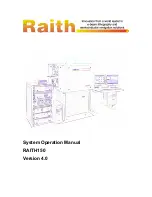
D00219 Revision E
– 2019-07-19 - Page 20
CAUTION: When the VScript is edited, take note of the VScript number. If the VScript is
saved without changing the VScript Ref#, the file on disk will be replaced. To create a new
script, change the VScript Ref# to a new number before saving. It is recommended when
editing an existing PinScript file using a text editor, open the original file and immediately
SAVE AS to the new file name, in the format ETS9910VSxxxx.TXT.
Care must be taken to follow the file format as shown below. The delimiter is a TAB character
which is easier to work with if you use a ¶ option in your editor to make tab characters visible.
The first record of this file is:
“ETS9910VS” <TAB> #
-of-steps <TAB> description <RETN>
The second record contains a list of numbers representing voltages to be applied during the test:
Voltage# <TAB> Voltage# <TAB> Voltage# <TAB> Voltage# ….. <TAB> Voltage#
<RETN>.
Example:
ETS9910VS <TAB> 5 <TAB> Low voltage sweep 50-90 <RETN>
50 <TAB> 60 <TAB> 70 <TAB> 80 <TAB> 90 <RETN>
Remember to verify that the “#
-of-
steps” parameter in the first record agrees with the script
length.
5.7 Testing Order
The operator can choose one of two test methods, depending on the objective of the test:
(1.) Sequence by voltages, then by pins: Connects to a pin pair, then applies all scripted voltages,
then step to the next pin, etc. This allows monitoring for ESD damage live during the test and
enables identification of the exact discharge voltage which caused the problem.
(2.) Sequence by pins, then by voltages: PinScan selects a voltage, then sequences through the
entire PinScript, then selects the next voltage, etc. This method supports verification of a device
at a particular voltage, for example “HBM Class 1A” requires that all device pins can withstand a
500V discharge.













































